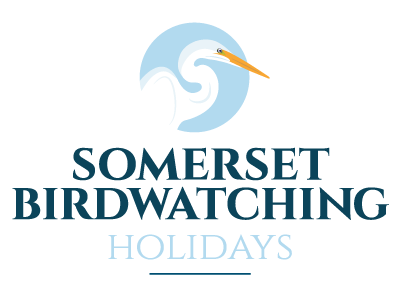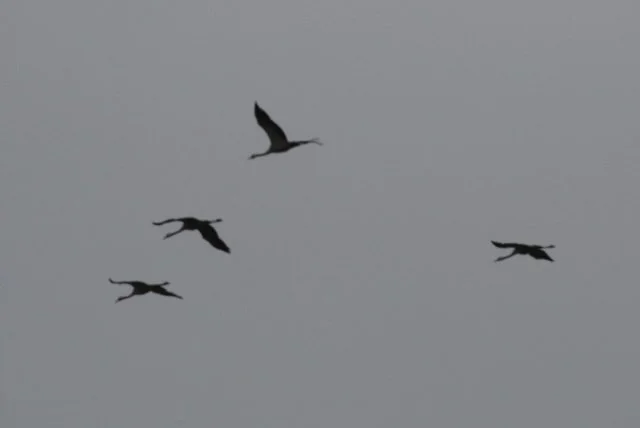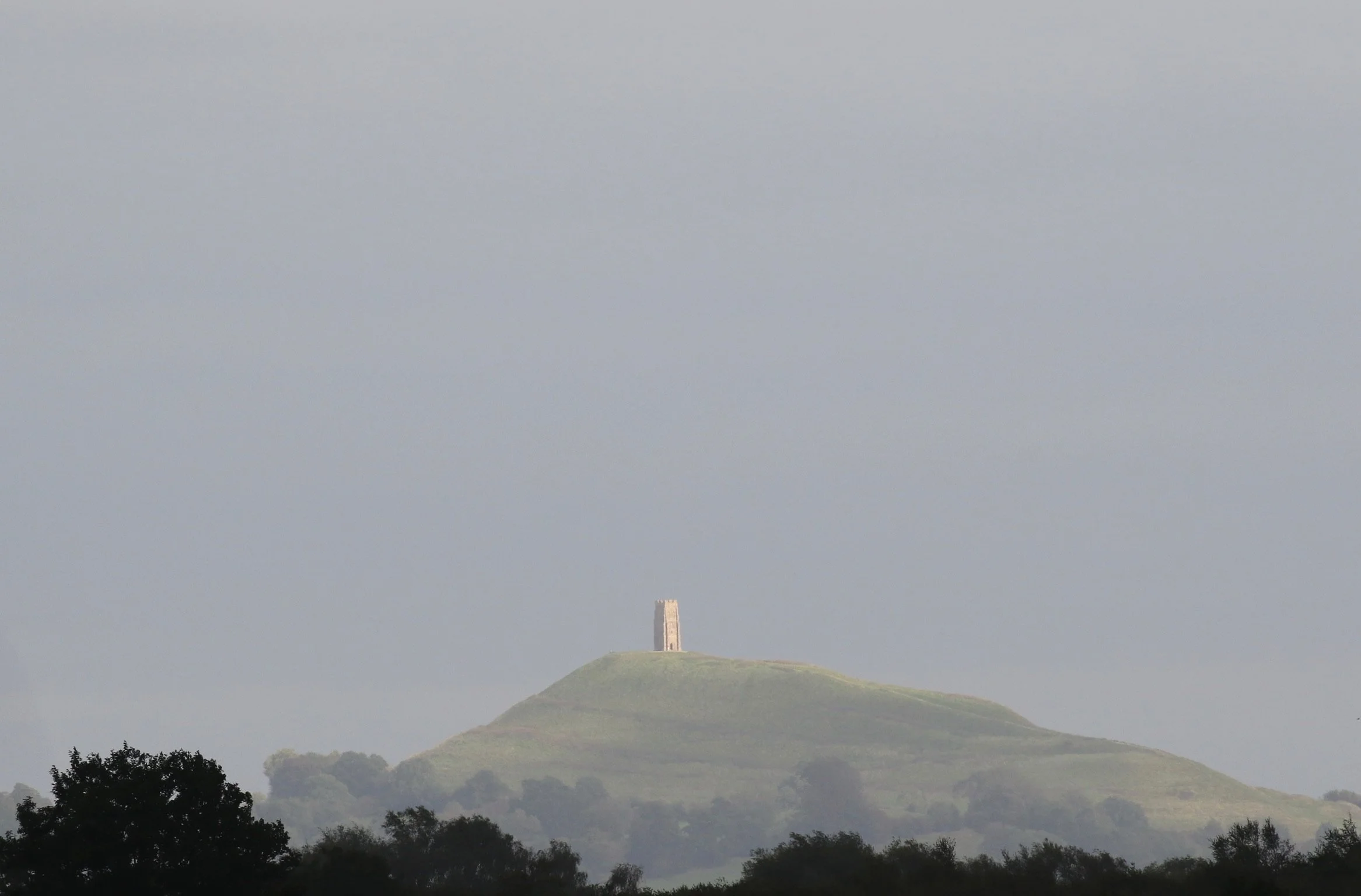Autumn Migrants Tour Report
TRIP REPORT: September 25th-28th 2023
Tour Leaders: Stephen Moss & Graeme Mitchell
Monday 25th September
Our Autumn tour started with a gentle walk around Walls Farm which proved to be quite productive for birds. We heard Green Woodpecker ‘yaffling’ from a neighbouring orchard and saw a Great Spotted Woodpecker fly over with its distinctive undulating flight. Two Ravens were cronking away to themselves from the top of a tall dark pine. We have wonderful views of these large corvids with their hefty chisel-shaped bills and thick-set necks. Two Speckled Wood butterflies spiralled above the brambles and sloe berries in the mild afternoon.
There were no Swallows – perhaps they’re gone now? In fact, we saw none all afternoon, just a small group of House Martins seen as we drove through the village of Blackford.
We parked the van at the end of Clyce Road in Highbridge, which runs parallel with the river Brue – ‘Clyce’ being the old Somerset word for a sluice gate or canal lock. Overlooking the Brue estuary our first group of waders was a nice mix of Redshank and Turnstones, and in the middle of them snoozing on one leg was a single Greenshank – larger than the other waders with a much lighter colouring than the other birds. At first, we thought it only had one leg, but eventually the other appeared just before it flew off.
A Kingfisher flew in and landed obligingly right in front of us giving wonderful views. It was a male bird with an all-black bill - the female would have had a red lower mandible (where she puts on her lipstick!)
Further down the sea wall there were larger groups of waders, brought in by the rising tide, again mostly Redshank and Turnstones, however one Bar-tailed Godwit and a single Common Sandpiper were noted amongst the throng. A male Kestrel was seen through the telescope, along with a single Curlew probing amongst the long grass and a Wheatear hopped along in front of our group using the Brue Estuary as a pit-stop on its long migration to sub-Saharan Africa.
Meadow Pipits did their thing, and a large flock of Linnets flew around our heads – Little Egrets dotted around the foreshore and out on Steart Island in the middle of the river Parrett estuary were many Shelducks lining the highwater mark. It was a nice gentle walk with some good birds – a perfect late summer/early autumn afternoon.
In the evening we were joined by Stephen over a delicious supper made by Kay where we planned out our birding activities for the next three days.
Tuesday 26th September
After a damp night, the weather cleared nicely to sunny, mild and breezy conditions, as we headed down to Tealham Moor for our first stop of the day. This and the adjacent Tadham Moor are not nature reserves, but are farmed very sympathetically, and with annual flooding each winter they are always worth a look at any time of year. Today was no exception: we were immediately greeted by five Cattle Egrets (our first of this tour) amongst the cattle, following these animals in the long, damp grass to pick up insects.
Scanning around, we found a nice Buzzard on a post, several Linnets and a female Reed Bunting perched briefly on a gate; followed by a Meadow Pipit and migrant Wheatear along a fence line, plus a distant Great White Egret, half a dozen Skylarks and a steady line of Swallows migrating south. As we drove off, eagle-eyed Graeme spotted a Hobby which gave brief views, a Kestrel and a Roe Deer.
We then drove over to the RSPB showpiece reserve at Ham Wall where, after coffee, tea and biscuits, we walked into the reserve along the disused railway line. On this now lovely autumn day we heard Robin singing, and saw a number of dragonflies – mostly the smaller Common Darters; plus a young Great Crested Grebe with its parent nearby, Coots, Tufted Ducks and Gadwalls, and heard Water Rail, Cetti’s Warbler and Little Grebe. From the first viewing platform we saw a distant female Marsh Harrier, and as we walked over to the Avalon Hide we saw a couple more, and a large female Buzzard, plus more Gadwall in flight, as well as enjoying a lovely view of Glastonbury Tor across the reedbeds.
From the hide itself (with its new 360-degree view!) we saw four Snipe in flight, more Coot, Gadwall and Little Grebes, a pair of Mute Swans with two youngsters, and lovely views of both female and male Marsh Harriers. On our walk back we caught sight of a semi-hidden Great White Egret, which then flew over our heads, and even more Swallows!
After our usual excellent lunch at the Duck in Burtle we dropped into the Somerset Wildlife Trust hide at Catcott Lows – to find that unfortunately the team were doing some necessary strimming of vegetation which had disturbed all the birds (though we did briefly see two Sparrowhawks at the top of the entrance track, and a pair of Kestrels both hovering north of the reserve). Westhay Moor, another SWT reserve, was also quiet, though we did enjoy distant Cattle Egrets, Shovelers, Moorhens, two distant Ravens and a female Marsh Harrier (seen perched in a tree from the Tower Hide), as well as a male Stonechat. On our way back we say 17 Cattle Egrets on Tadham Moor, and four Little Egrets with a single Cattle, a bit closer. Then back to Walls Farm for supper.
Wednesday 27th September
It was a blustery and grey morning as we headed over to Steart Marshes. The wind had picked up and we were mentally bracing ourselves for the first storm of the autumn (Storm Agnes) to make landfall in the afternoon.
The tide was miles out when we arrived which did not auger well as any self-respecting wader would be out feeding on the mudflats of Bridgwater Bay – indeed there were not many birds at all as we walked into the reserve, aside from a few groups of Starlings giving us a mini-murmuration along with some Goldfinches and a distant single Stonechat.
From the Quantock Hide the first impression of the lagoons were that they were empty, however before long we had spotted a couple of Little Egrets, several Teal, some Pied Wagtails and six Skylarks flew over our heads. Then right on cue in flew the most magnificent Spoonbill, heading straight past us and landing just a short distance from the hide, right next to a Little Egret. Boom! What a wonderful sight.
The bird did not stay long, just going to prove the point that with many things in life (particularly in birdwatching), it is all about being in the right place at the right time! The Spoonbill gave us a grand fly-past as it headed off showing off its wonderful long bill and trailing long legs, looking in some ways reminiscent of a flamingo in flight.
Spoonbill and Little Egret, photo Geoff Carss
Buoyed by this wonderful bird we headed off with renewed confidence to look over the northern section of Steart Marshes, an area we call the ‘Gobi Desert’, as it is usually birdless!
On the way over to the hide, we were accompanied by a large family of Long-tailed tits and hidden Cetti’s Warblers in the reedbeds. Once again, the view was virtually birdless aside for a few Skylarks and a distant hovering Kestrel.
We had our coffee break from the back of the van at the Wall Common carpark and had a brief glimpse of a low-flying Peregrine as it swept past on a smash and grab beachside attack. From the pebbly beach, the tide was so far out, it felt that you could walk right over to Cardiff which we could see way off in the distance beyond the mudflats which were covered with Shelducks, gulls and several dotted Curlews and Little Egrets.
As the wind was picking up, we returned inland for more shelter and found it in the cosy King Alfred Inn by Burrowbridge. Storm Agnes was really kicking off as we left the pub after a hearty lunch, however after a quick cultural stop at Athelney (where King Alfred burnt the cakes) the rain had slightly eased, so we braved the elements at Stathe Bridge by the River Parrett and were rewarded with 11 Cranes flying in a v-formation close overhead giving us excellent views. Again, we were in exactly the right place at the right time – no luck at all, as Graeme confirmed it was all about the expert planning!?
Cranes, photo Geoff Carss
At RSPB Swell Wood, the large oaks were swaying like a mosh-pit at a rock concert, but we still managed to view a further six Cranes from the viewpoint over West Sedgemoor – one pair having a fully-grown juvenile close by. Seventeen Cranes was considered a great tally for the day, and just as we were getting back into the van we saw Coal, Great and a single Marsh Tit in the carpark.
Despite the day’s challenging conditions, we had seen some great birds, and the day concluded with a quick stop at Somerset Wildlife Trust’s reserve at Catcott which offered fine views of a sunlit Glastonbury Tor but little in the way of birdlife aside from two most graceful Great White Egrets.
Glastonbury Tor from Catcott hide, photo Geoff Carss
Thursday 28th September
On another dry and reasonably sunny, mild and still morning, we headed over once again to Graeme and Stephen’s local patch, the ‘three rivers’, this time approaching from the Huntspill end. From Sloway Bridge we heard two Cetti’s Warbler singing, and saw a dozen Moorhens and brief view of a female Sparrowhawk, plus four Collared Doves.
At the sluice itself, the tide was very low, but nevertheless there were small flocks of Teal (still in eclipse plumage) and newly-arrived Wigeon, plus Little Egret; then Graeme spotted two female Marsh Harriers on the far side of the River Parrett: one in flight and the other perched on a post.
As we walked along the ‘sea wall’, things began to hot up, with lots of smaller birds feeding on the grass newly-exposed by the lowering tide. There were two Ravens low overhead (and later seem on the grassy bank), good numbers of Skylarks, Meadow Pipits, Linnet and a couple of Reed Buntings (including a breeding male), and at least 3, probably 4 Wheatears including a splendid male. Stephen then spotted two young Peregrines (looking small so probably males) along the far side of Parrett, and one had a go at a Shelduck; there were also Curlew there; and as the tide dropped, about 100 Avocets started feeding on the mud on our side, giving good views. Finally a female Sparrowhawk (our fifth or sixth of the trip!) flew high amongst a flock of small birds accompanied by an angry crow, and a hovering Kestrel as we left.
For our final visit for the trip, we drove over to Cheddar Reservoir, where the water level was very low, providing a roosting place for lots of Black-headed Gulls, Teal, Canada Geese and Cormorants; on the water we say several thousand Coots and a number of Great Crested Grebes, including a youngster; before we drive back to Walls Farm and said our goodbyes, at the end of another excellent trip.



